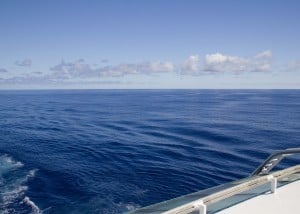The cruise take five full days from Vancouver to Hawaii, I’m sitting on my balcony on the 4th day of open cruising enjoying the first truly tropical feeling day of the cruise. The wind has died down to about 5-6 knots of direct head wind.
We’ve been experimenting with and observing science though, as that is just a part of my nature. With so much open ocean and equally open skies, one can make observations on the effects of light. And experiment a little with polarizing lens. Your typical polarized sun glasses are set up to stop glare from horizontal surfaces, like car hoods, chrome bumpers and things like that. When you rotate them 90 degrees, the light that passes through changes. You’ll see the sky change colors as well as the clouds and the contrast in the sea changes as well.
I have a circular polarizing filter on my camera that allows me to change the orientation of the light as well, and so I took pictures of the same scene from our balcony with the filter turned 90 degrees. You can see the significant difference in the same scene below.


It is this trick of light orientation that is used in modern 3D film making, by putting on glasses with the light polarizing at 90 degrees difference, the filmmaker can take advantage to cause one eye to see something slightly different than the other. Our brain combines these two images to create a 3 dimensional view of whatever is on the screen.
Seeing things in different ways is one of those things that engineers are supposed to do. We are trained to solve problems and find better solutions to problem presented to us. However, there are three traps that affect our ability to get to the best solution.
1) We get stuck in a rut of seeing the problem in only one way and thus seeing only a single solution. The definition of idiocy is doing the same thing over and over and expecting different results.
2) We have a solution, but no corresponding problem. solution in search of a problem
3) Sometimes we are only comfortable with a few solutions so we try to make our problem fit. If all you have is a hammer, everything begins to look like a nail.
Even people in policy making positions that are supposed to spend their time finding innovative solutions to difficult problems can get caught in any of these three traps. Worse, for some policy-makers and organizations it becomes more about keeping a reason for the organization’s existence alive. It becomes more important to sustain the agency that to solve the problem for which the agency was developed. Or the founders of the organization can’t see changing circumstances that make their pet solution or problem irrelevant.
I have spent many years taking my problem solving skills and applying them to problems in unique ways. One thing I’ve found is that by spending time ensuring that your organization truly comprehends and agrees on the problem that is being solved, you are much more likely to find creative solutions that actually fix the problem rather than the symptoms. So many times an organization gets caught up in the way things “should be” or the way people want them to be rather than the way things really are. When an organization spends the time understanding this, it can be a powerful tool for recognizing when a profound change in direction is required and finding ways to make that change happen.
The energy policy of the United States is in need of such an effort. Too many people have their polarizing sunglasses on and oriented in only one direction so they see solutions only in the light their eyes are receiving. The lack of a comprehensive long term strategy for the nation is putting us at peril for our ability to remain leaders in the world. Our country’s policy has been at the mercy of too many shortsighted interest groups and politicians looking for short term gains in order to win or maintain power in the immediate term. We desperately need leadership in government that can stand up and look at the science and the need and develop a road map to the next millennium.

I can think of one federal agency in particular whose reason for being would evaporate if it did anything with a realistic chance of solving the problem it was formed to address.
Where would the DOE be if we had simply kept on building new nuclear power plants instead of stopping the groundbreakings in the mid 1970s – just at the time that the DOE was being formed out of the ERDA and other assorted federal agencies?
The DOE has been, and continues to be, a misnamed agency that needs a serious reorganizations. It has responsibilities that have nothing to do with national energy policy or development. The fact that a fair fraction of its budget is for the military aspects of the national labs frustrates me completely. That should be under the DOD. If DOE actually worked on energy and only energy, maybe they would accomplish something.
BTW – nuclear energy is one very flexible hammer than can turn a wide variety of problems into relatively easy to pound nails.